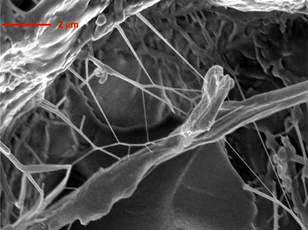Many epoxy composites are now incorporated into the design of jets, planes and other vehicles.
Composite materials are extremely lightweight, which lowers the overall weight of the vehicle and boosts fuel efficiency.
The downside is that epoxy composites can be brittle, which is detrimental to the vehicle’s structural integrity.
Now, a researcher at Rensselaer Polytechnic has demonstrated that incorporating chemically treated carbon nanotubes into an epoxy composite can significantly improve the overall toughness, fatigue resistance and durability of a composite frame.
When subjected to repetitive stress, a composite frame infused with treated nanotubes exhibited a five-fold reduction in crack growth-rate compared with a frame infused with untreated nanotubes; when compared with a composite frame made without nanotubes, it exhibited a 20-fold reduction.
This newfound toughness and crack resistance is a result of the treated nanotubes, which enhance the molecular mobility of the epoxy at the interface where the two materials touch.
When stressed, this enhanced mobility enables the epoxy to craze - resulting in the formation of a network of pillar-like fibres that bridge together both sides of the crack and slow its growth.
'This crazing behaviour and the bridging fibres it produces dramatically slow the growth rate of a crack,' said Prof Nikhil Koratkar of
'In order for the crack to grow, those fibres have to first stretch, deform plastically and then break.
'It takes a lot of energy to stretch and break those fibres, energy that would have otherwise gone towards enlarging the crack.
'We didn’t expect this at all.
'Crazing is common in certain types of thermoplastic polymers, but very unusual in the type of epoxy composite we used.
'In addition to improved fatigue resistance and toughness, the treated nanotubes also enhanced the stiffness, hardness and strength of the epoxy composite, which is very important for structural applications.'
Koratkar's research group plans to further investigate crazing behaviour in epoxy composites, to better understand why the chemical treatment of nanotubes initiates crazing.

The crazing, which causes the composite to deform into a network of nanoscale pillar-like fibres that bridge together both sides of a crack and slow its growth, could lead to tougher, more durable components for aircraft and automobiles



Nanogenerator consumes CO2 to generate electricity
Nice to see my my views being backed up by no less a figure than Sabine Hossenfelder https://youtu.be/QoJzs4fA4fo